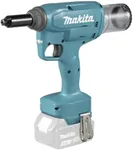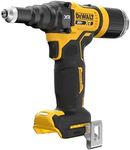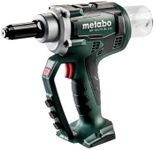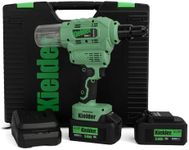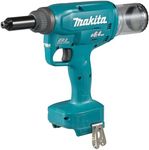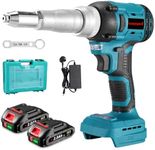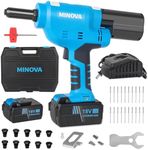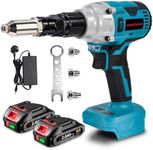Buying Guide for the Best Cordless Rivet Guns
Choosing the right cordless rivet gun can make your riveting tasks much easier and more efficient. A cordless rivet gun is a versatile tool that allows you to fasten materials together without the need for a power outlet or air compressor. When selecting a cordless rivet gun, it's important to consider several key specifications to ensure you get the best fit for your needs. Understanding these specs will help you make an informed decision and choose a tool that will serve you well for your specific applications.Battery Type and CapacityThe battery type and capacity determine how long the rivet gun can operate on a single charge and how powerful it is. Most cordless rivet guns use lithium-ion batteries, which are known for their long life and quick charging times. Battery capacity is measured in ampere-hours (Ah); higher Ah means longer runtime. If you have heavy-duty tasks or need to use the tool for extended periods, look for a higher capacity battery (e.g., 4.0Ah or more). For lighter, occasional use, a lower capacity battery (e.g., 2.0Ah) may suffice.
Pulling ForcePulling force is the amount of force the rivet gun can exert to pull the rivet and secure it in place. This is usually measured in Newtons (N) or pounds-force (lbf). Higher pulling force means the tool can handle larger and tougher rivets. For heavy-duty applications, such as working with thick materials or large rivets, look for a rivet gun with a higher pulling force (e.g., 20,000N or more). For lighter tasks, a lower pulling force (e.g., 10,000N) will be sufficient.
Rivet Size CompatibilityRivet size compatibility refers to the range of rivet diameters the gun can handle. This is important because using the wrong size rivet can lead to poor fastening and potential damage. Common sizes range from 3/32 inch to 1/4 inch. If you work with a variety of materials and rivet sizes, choose a rivet gun that can accommodate a wide range of sizes. If your tasks are more specialized, ensure the tool is compatible with the specific rivet sizes you use most frequently.
Weight and ErgonomicsThe weight and ergonomics of the rivet gun affect how comfortable it is to use, especially for extended periods. A lighter tool reduces fatigue, while ergonomic designs with comfortable grips and balanced weight distribution make the tool easier to handle. If you have to use the rivet gun for long durations or in awkward positions, prioritize a lightweight and ergonomically designed model. For occasional or short-term use, weight and ergonomics may be less critical.
Cycle TimeCycle time is the time it takes for the rivet gun to complete one riveting cycle, from pulling the trigger to setting the rivet and being ready for the next one. Faster cycle times mean you can work more quickly and efficiently. If you have high-volume riveting tasks, look for a rivet gun with a shorter cycle time (e.g., 1-2 seconds). For occasional or low-volume use, a longer cycle time (e.g., 3-4 seconds) may be acceptable.
Durability and Build QualityDurability and build quality determine how well the rivet gun will withstand regular use and harsh conditions. Look for tools made from high-quality materials like metal and reinforced plastics. Features like dust and water resistance can also enhance durability. If you need a tool for professional or heavy-duty use, prioritize models known for their robust construction. For light or occasional use, standard build quality may be sufficient.


